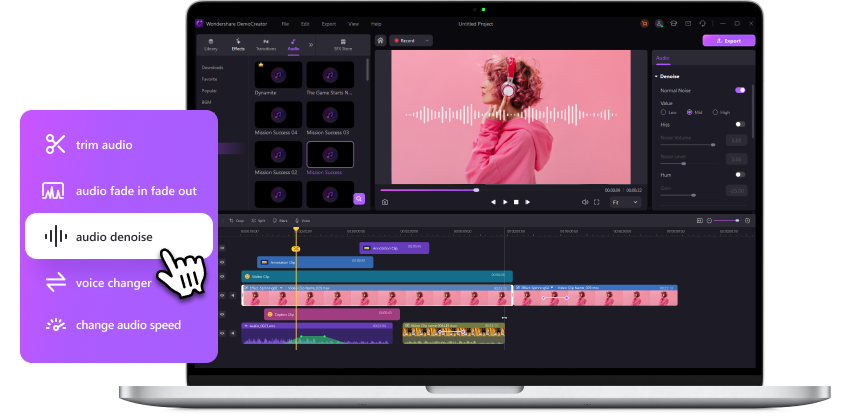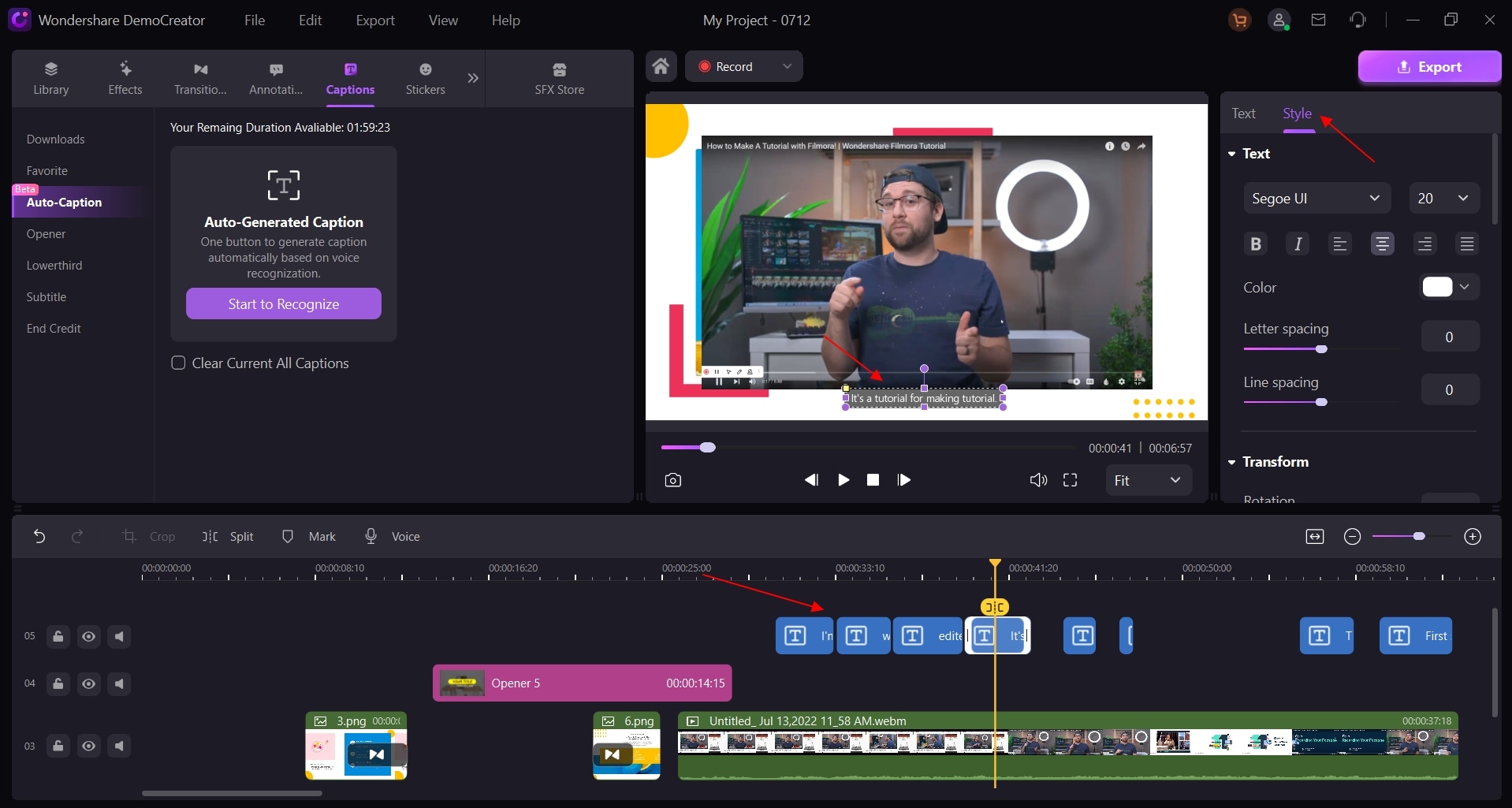Audacity and GarageBand are among the most loved audio recording and editing tools. Podcasters, musicians, sound engineers, audiobook producers, and other audio professionals swear by them. The question is, is Audacity better than GarageBand or vice versa?
Buckle up for the ultimate Audacity vs. GarageBand rundown to explore their top features, ease of use, best uses, and pricing. We'll introduce a worthy alternative that throws video recording and editing capabilities into the audio mix, so sit back and enjoy the ride.
Table of Content
Audacity vs. GarageBand - General Overview
Audacity is a digital audio editor with cross-platform compatibility, available on Windows (10 and 11), macOS (Monterey and Ventura), and Linux-based systems (Ubuntu 22.04). It has many editing features and supports audio recording, letting you add multiple channels and record them as separate tracks.
This advanced software is open-source, meaning you can modify the source code to customize it to your needs and preferences.

GarageBand is a digital audio workstation (DAW) exclusive to macOS, iOS, and iPadOS. Apple developed it for Mac computers in 2004 but has since removed it from older macOS systems. It now requires macOS Big Sur or newer. It's one of the best free music recording software for Mac.
Apple expanded GarageBand's platform compatibility in 2011, creating a mobile app for on-the-go multi-track recording and editing. It's compatible with iOS 17.4 or newer and iPadOS 17.4 or later.

Audacity vs. GarageBand - Key Features
Audacity and GarageBand have similar audio recording and editing features. However, the former focuses more on fine-tuning your recordings. The latter gives you more creative freedom, letting you create music from scratch (with or without a physical instrument) and perfecting it in post-production. Here are more details about each.
Audacity
Audacity's most notable features include the following:
- Multi-channel audio recording - record your voice, system audio, and other channels, even VHS tapes, TVs, and old cameras;
- Customizable sample rate - choose from 44.1 kHz, 41 kHz, 48 kHz, and 96 kHz;
- Multi-track editing - adjust the speed, tempo, and pitch, remove noise, import background music, and use cutting, splitting, trimming, and resizing tools;
- Digital effects and plugins - add the bass, treble, reverb, echo, distortion, fade-ins, fade-outs, and third-party plugins (AU, VST, VST3, LV2, LADSPA, and Nyquist);
- Multi-format support - import and export MP3, WAV, FLAC, M4A (AAC), AC3, WMA, and many other audio files.
Unfortunately, Audacity has no MIDI recording support. It can only record your microphone, speakers, and other connected playback devices.
However, individual tracks can have up to two channels (mono or stereo). What if you use an eight-channel mixer for a podcast? Audacity can record each channel as a separate track.

Audacity lets you simultaneously edit multiple tracks and add digital effects to entire files or specific parts. It may not have a built-in library of loops, music, and other creative assets, but its non-destructive editing makes undoing changes seamless.
Besides mixing and panning tracks and enjoying batch processing, you can create backing tracks. For instance, you can import a song and remove the voice to convert it into a rhythm track. You can then record your vocals and make a unique cover.

Audacity's effects include reverb, echo, breaks, fade-ins, fade-outs, distortion, amplification, and noise removal (e.g., clicks and hums). You can also speed up or slow down the tempo, pitch, and speed, normalize audio levels, and manipulate sounds using a graphic EQ.

Once you polish your recordings, you can export them as MP3, WAV, Ogg Vorbis, Opus, FLAC, WavPack, M4A (AAC), AC3, WMA, MP2, or custom FFmeg. Additionally, Audacity supports many uncompressed formats like RAW and CAF, making it ideal for sizable multi-channel files.

Read more:
- How to record system audio in Audacity
- How to record audio from YouTube in Audacity
- How to extract audio from video in Audacity
GarageBand
GarageBand's most prominent features include:
- Multi-track and multi-take recording - simultaneously record your microphone, speakers, and other channels and make multiple takes in a region;
- MIDI recording support - plug in your keyboard, guitar, or drums and record your voice and music;
- Virtual software instruments - add a piano, bass, synthesizer, guitar, or another instrument to create original music and make real-time adjustments with Smart Controls and an interactive visual EQ;
- Drummer - choose from 28 drummers and three percussionists to create beats with a virtual session player;
- Multi-track editing - simultaneously edit multiple tracks, add background music and sound effects, and synchronize notes with Flex Time;
- Apple Loops - enrich your recordings with a vast library of pre-recorded rhythm sounds, drum beats, bass lines, and royalty-free music;
- Built-in music lessons - Master the guitar or piano with animated instruments and demos across 40 genres, track your progress, and get feedback;
- Seamless sharing - export your creations to a disk, iCloud, and Music, share them via Mail Drop or AirDrop, and burn them to a CD.
As you can see, GarageBand is more feature-rich than Audacity. It supports only 41 kHz, but that's a standard sample rate for consumer audio.
It's perfect if you rely on MIDI recordings, but virtual instruments can also take your music creation to the next level.

GarageBand has podcast-specific settings, letting you choose a suitable template for your podcast (e.g., discussion, interview, and solo). It offers automatic audio normalization, EQ presets, one-click compression, and an extensive audio effect library.

GarageBand's library with music, effects, loops, digital amps, and other pre-recorded sounds is ideal for creating tracks from scratch. You can make intros and outros and add background music, echo, reverb, distortion, and other effects across instruments and genres. The drag-and-drop functionality makes it a breeze.

The virtual Drummer with presets for professional-sounding edits offers customizable loops, fills, swings, grooves, and other effects. Its myriad amps can work wonders for your music.

Audio-track color coding makes editing a walk in the park. Besides creating and mixing up to 255 tracks, you can tweak them all simultaneously and save multiple versions. You can also undo changes and eliminate background noise.

GarageBand can be your best ally when inspiration strikes, but you're away from your Mac. Its iCloud integration lets you edit your tracks on your iPhone or iPad and resume the work on your Mac.

GarageBand supports fewer export formats than Audacity, including only AAC (M4A), MP3, AIFF, and WAVE. That may be the only drawback.

Further reading:
Audacity vs. GarageBand - Ease of Use

Audacity hasn't changed much since 2000. It has a dated UI, making you think it's less functional than it is. On the contrary, it's a remarkable audio editor. It's straightforward and ideal for quick recordings.
However, its feature-rich interface has a steep learning curve, making it better for experienced users. If you're a beginner, you'll likely find it complex and consider more intuitive alternatives.
GarageBand is one of them. It's user-friendly and visually appealing, but newbies may find it intimidating because of the numerous features. Users with a musical background or sound editing experience don't have trouble navigating it.
Still, getting the hang of this beginner-to-intermediate tool is faster than mastering Audacity.
Audacity vs. GarageBand - Best Uses

Audacity is excellent for audio editing, although it can create high-quality recordings. It's best for musicians, podcasters, and bedroom producers seeking professional software for quick recordings and quality post-production work.
Likewise, GarageBand is fantastic for podcasting and audio editing. It also supports music production, making it more suitable for bands, DJs, and other musicians.
Which one wins in the battle of Audacity vs. GarageBand for podcast recording and editing? The answer lies in your needs and preferences.
Audacity is a no-brainer if you use Windows or Linux. If you're a Mac user, pick Audacity for a higher sample rate and seamless recordings that don't require unique effects, loops, and other advanced tweaks. On the other hand, choose GarageBand for podcasting presets, MIDI recordings, virtual instruments, and extensive post-production.
Audacity vs. GarageBand - Pricing
Both Audacity and GarageBand are free. However, Audacity is open-source digital audio editing software, while GarageBand is a built-in DAW on Mac devices.
Bonus Tool for Audio and Video Recording - DemoCreator
Wondershare DemoCreator is your go-to option for top-notch audio and video recordings. It can record screen, audio, and webcam simultaneously or separately, making it ideal for recording online courses, live streams, gameplay, business presentations, product demos, and much more.
You can also record audio only, capturing your microphone and system sounds. You can trim the audio, add fade-ins and fade-outs, adjust the speed, change your voice, and remove background noise like hums, hisses, and clicks. You can get crisp audio for podcast episodes, audiobooks, voiceovers, music production, and other audio needs.

DemoCreator's Video Editor is superb for all video content creators, including educators, business professionals, and vloggers. It has many AI-powered features for taking your creations to the next level.
Besides an AI denoiser and voice changer, you use an auto-caption and subtitle generator, animate subtitles, and add transitions, audio and video effects, dynamic stickers, filters, and other creative assets.

The best part is multi-track editing. DemoCreator records your screen, camera, microphone, and system audio separately, helping you fine-tune all tracks seamlessly.

Try it for free if you need crystal-clear sound and advanced video recording and editing. If you're a gamer, you'll love its game-integrated recording mode that captures 4K and 8K videos at 120 FPS, regardless of screen resolution.
Conclusion
Hopefully, this thorough GarageBand vs. Audacity comparison will help you pick your favorite. Each software is an excellent choice; your decision depends on your preferences.
We recommend trying both because you have nothing to lose; they're free. However, Wondershare DemoCreator has something they don't—video recording and editing capabilities. Download it to your PC or Mac to see how it fits your needs.
You may also be interested in: Audacity vs Audition
FAQs About Audacity and Garageband
-
Is Audacity better than GarageBand?
Audacity is better for audio editing and mixing. It lets you tweak music and podcast recordings quickly. GarageBand is ideal for unleashing creativity with MIDI recording and a complete music production package. -
Which should I pick, Audacity or GarageBand?
Choose Audacity if you're looking for advanced audio manipulation and can do without music production support. GarageBand supports music creation and offers many extras in an intuitive interface. That makes it better for beginners, musicians, and audio producers. -
Which one is better for podcasts, Audacity or GarageBand?
Audacity is better for podcasts that don't require extensive editing. Use it if your episodes cover interviews, discussions, and commentaries and only need intro and outro music and standard effects. GarageBand can be excellent for podcasts with heavy post-production (e.g., narrating stories and using many effects). Still, music production is its strongest suit.




